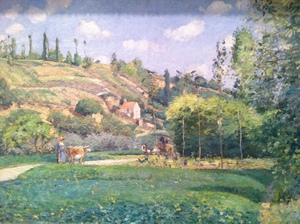Pissarro
On Photography I
Saturday, October 5, 2013

Pissarro, A Cowherd at Valhermeil, 1874, iphone.
After years of scorning people who come to museums and take pictures – souvenir-hunters! they don’t even look at the paintings! – on Tuesday I found myself in the Impressionist rooms at the Met zealously photographing details with my iphone held up in front of the canvases. I had two impulses, or justifications: it seemed expedient – I was in New York for a day only, had a mere hour with the pictures – this was a way to take notes. And at the same time, or even before the thought of expediency occurred to me, I also knew that having details of paintings is very helpful if you are going to post about them. Already the fact of keeping this notebook is changing the way I go to museums.
The second picture I took showed me that the modest magnification of the iphone makes an enormous difference in what you can see. I started with some little Boudin figures at the beach:


I have always felt that if you wait long enough and give yourself patiently to the act of looking your eye will learn to see at this level of detail. But here, presto, the machine could do it instantly – and then looking at the painting with the naked eye I could see it all myself, trained, in a second, by the clarification of the machine.
As I went on, taking pictures of Constables and Daubignys, and made my way to the Pissarro room, I began to experience some of the pitfalls of the new method. The iphone camera overclarifies. It sharpens contrasts, defines edges where the paint is deliberately ambiguous. So that I was in fact learning to see a painting that wasn’t the painting I was looking at. I had to try to compensate in the other direction, photographing so quickly that the camera had not yet quite had time to resolve the image, and this seemed to more clearly approximate the paint as it was actually there.
Still, the exciting thing was that I could actually keep track of the sequence of my observations. For example, I saw this beautiful Pissarro from 1874, the year of the first great Impressionist exhibition, painted at Pontoise, one of Pissarro’s favorite places to paint.
I saw the picture whole:

Then my eye went to this passage of paint in the foreground:

Then to the cowherd of the picture’s title:

A cart further along:

Paint to right foreground, the yellow, blues and lavendars:

Stretch of cultivated field down to earth:

[ Technology suggests and constrains. I find I am limited in the number of images I can post. Just at this moment of drama, when we are about to see further into the picture, I will have to ask my reader to wait. The rest of the sequence will be found under Pissarro, On Photography II ]